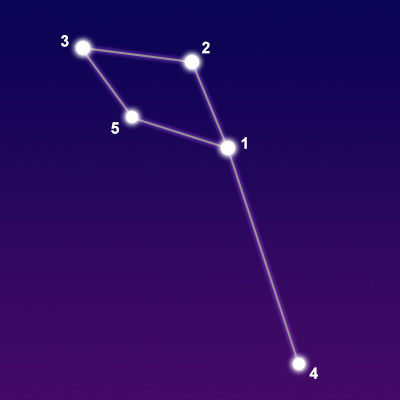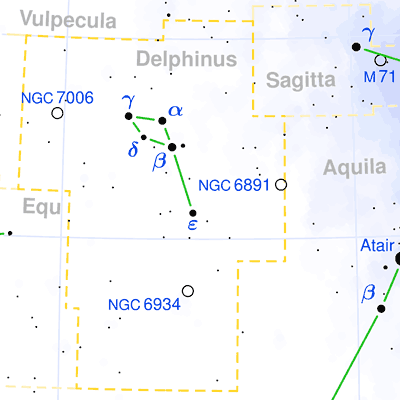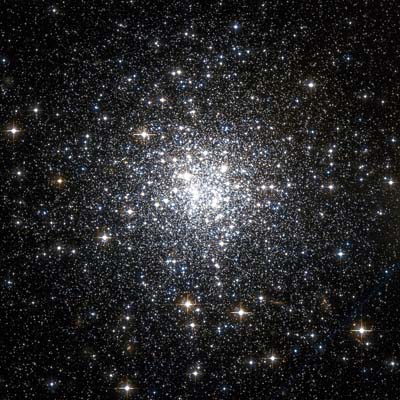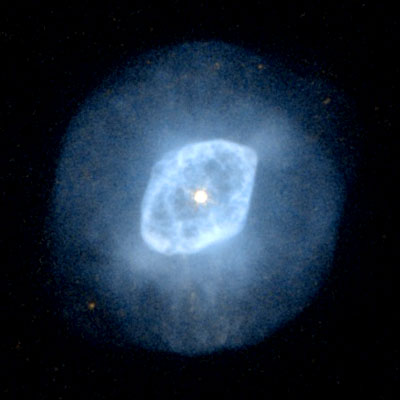Pronunciation:
(del-FY-nus)Abbreviation:
DelGenitive:
DelphiniRight Ascension:
21 hoursDeclination:
10 degreesArea in Square Degrees:
189Crosses Meridian:
9 PM, September 15Visible Between Latitudes:
90 and -70 degreesThe constellation Delphinus, the dolphin, is visible in late summer from the Northern Hemisphere. It can be seen at latitudes between 90 degrees and -70 degrees. It is a small constellation, occupying an area of only 189 square degrees. This ranks it 69th in size among the 88 constellations in the night sky. This constellation is bordered by Aquarius, Aquila, Equuleus, Pegasus, Sagitta, and Vulpecula. It bears a remarkable resemblance to a dolphin leaping out of the water. Because of this shape, it is easy to recognize in the sky.
Delphinus is one of the 48 constellations cataloged by the Greek astronomer Ptolemy in the second century. Its name means “the dolphin” in Latin. It is an old constellation with roots in many ancient cultures. The Chinese knew it as the Black Tortoise of the North. On the island of Pakapuka, it was called Te Toloa. The people of the Tuamotus islands called it Te Oru-o-tiki. In Greek mythology, it was believed to represent a dolphin that helped Poseidon locate the mermaid, Amphitrite, whom he wished to marry. As a reward, Poseidon placed the dolphin among the stars. In another version of the myth, the god Apollo placed the dolphin in the sky for saving the life of Arion, a musician from the island of Lesbos who was skilled with the Lyre. Apollo placed the dolphin next the constellation Lyra, which represented Arion’s Lyre.

points of interest below © Sea and Sky

© Torsten Bronger CC BY-SA 3.0
Sualocin
Gamma Delphini
Deneb Dulfim
Delta Delphini
"Nicolaus" Spelled Backwards
N/A
"Tail of the Dolphin"
N/A
Multiple Star System
Binary Star System
Blue-White Giant Star
Binary Star System
3.77
3.87
4.03
4.38
This small constellation contains a few moderately bright stars. Rotanev is the brightest with a visual magnitude of 3.64. It is a binary star system located approximately 101 light years from Earth. Sualocin is the second brightest star with a magnitude of 3.77. It is a multiple star system composed of seven individual stars located 241 light years from our solar system. At magnitude 3.87, Gamma Delphini is the third brightest star. It is a binary star system that lies some 101 light years distant.
Delphinus contains no Messier objects but does contain a few notable deep-sky objects. It lies within a rich Milky Way star field populated with nebulas and star clusters. These objects are extremely dim and can only be seen in large telescopes. They include a planetary nebula known as the Blue Flash Nebula (NGC 6891) and several globular star clusters, each containing hundreds of thousands of stars. NGC 6934 is a globular cluster located approximately 50,000 light years from Earth. NGC 7006 is another globular cluster located some 135,000 light-years away. It is part of our galaxy's galactic halo, a spherical region around the galaxy made up of dark matter, gas and sparsely distributed star clusters.

the Hubble Space Telescope

© Fabian RRRR / CC BY-SA



